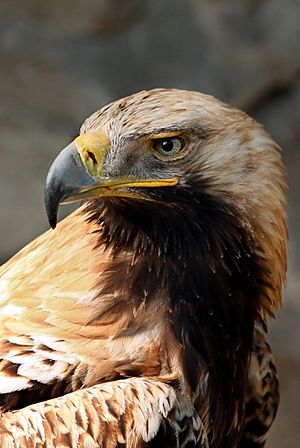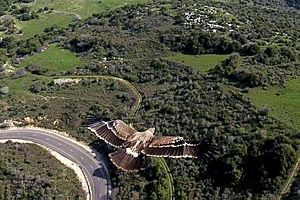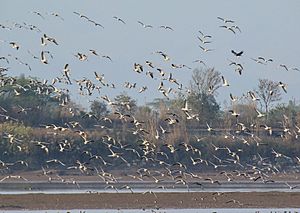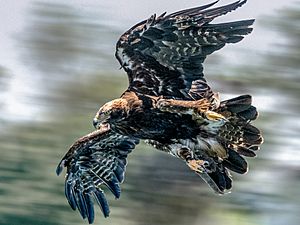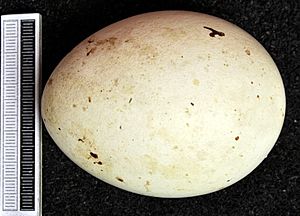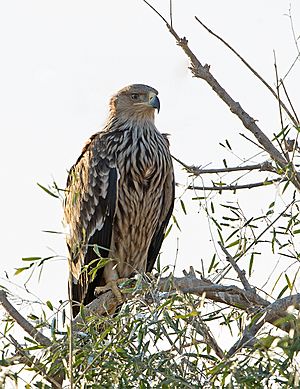Eastern imperial eagle facts for kids
The eastern imperial eagle (Aquila heliaca) is a very large bird of prey. It lives and breeds in southeastern Europe and across West Asia and Central Asia. Most of these eagles fly south for winter. They spend the colder months in northeastern Africa, the Middle East, and parts of South Asia and East Asia.
Like all eagles, the eastern imperial eagle belongs to the family Accipitridae. Its feathered legs show it is part of the Aquilinae group. This eagle is large and dark-colored. It looks similar to other Aquila eagles. However, it is usually the darkest eagle in its home range.
This eagle is a clever hunter. It mostly eats small mammals. But it also hunts many birds, reptiles, and other animals. Sometimes, it even eats carrion (dead animals). Unlike some other Aquila eagles, it likes to live where tall forests meet open plains. It also likes steppe areas with scattered trees. These eagles usually build their nests in big, old trees. They typically raise one or two young eagles each year.
The number of eastern imperial eagles in the world is small. Their population is shrinking. This is because of hunting, losing their homes, and less food. Because of this, the IUCN Red List has listed them as a Vulnerable species since 1994.
Quick facts for kids Eastern imperial eagle |
|
|---|---|
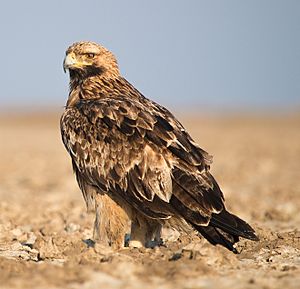 |
|
| A young eagle with its changing feathers in the Little Rann of Kutch | |
| Conservation status | |
| Scientific classification | |
| Genus: |
Aquila
|
| Species: |
heliaca
|
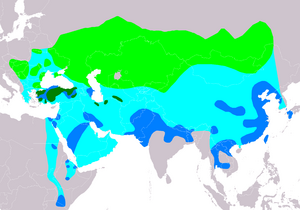 |
|
| Where Aquila heliaca lives:
Breeding Resident Passage Non-breeding |
|
| Synonyms | |
|
Aquila heliaca heliaca |
|
Contents
Eastern Imperial Eagle Description
The eastern imperial eagle is a large bird. It is about average size for the big Aquila eagle group. Adult eagles are usually 68 to 90 cm (27 to 35 in) long. Their wings can spread from 1.76 to 2.2 m (5 ft 9 in to 7 ft 3 in) wide.
Female eagles are usually bigger than males. This is called reverse sexual dimorphism. Females can be up to 10% longer and 40% heavier than males. Males typically weigh around 2.6 kg (5.7 lb). Females are heavier, often around 3.9 kg (8.6 lb).
Eagle Calls and Sounds
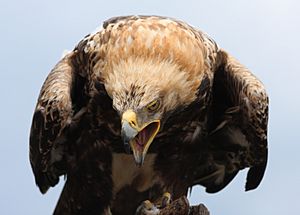
Eastern imperial eagles are quite noisy when they are breeding. But they are usually quiet at other times. Their main call is a deep, harsh sound like owk owk or kraw-kraw. They often repeat this call quickly, up to 8-10 times.
Their call is deeper and stronger than a golden eagle's call. Sometimes, when they call for a long time, it sounds like a big frog croaking. These eagles call most often when they are flying in displays. Females also call when a male brings food. They have alarm calls too, like a soft ko-gok for a distant threat.
Where Eastern Imperial Eagles Live
Breeding Areas
The eastern imperial eagle breeds in many countries. In Europe, they are found in eastern Austria, Hungary, Slovakia, and parts of the Ukraine. Their breeding range continues across Russia, through Central Asia, and into northern Mongolia and northwestern China.
Smaller groups also live in Turkey, Cyprus, and northern Iran. Sadly, they have probably disappeared as breeding birds from Afghanistan and Pakistan.
Migration and Winter Homes
Unlike the Spanish imperial eagle, most eastern imperial eagles migrate. They fly to warmer places for winter. They start migrating in fall (September to November). They return in spring (February to May).
These eagles winter in the Middle East, including Israel and Saudi Arabia. Some also fly to Africa, mainly in the Nile valley. This includes southern Sudan and northern Kenya. Eagles from eastern breeding areas, like around Lake Baikal, often fly to South Asia.
They spend winter in the Indian subcontinent, from Pakistan to Bangladesh. They also winter in southern Bhutan and parts of Thailand and China. Sometimes, they are seen in Cambodia, Laos, Vietnam, Korean peninsula, Taiwan, and southern Japan.
Eagle Habitats
Eastern imperial eagles usually breed along the southern edge of large taiga forests. They prefer open areas with scattered trees or woodlands. They also like areas near wetlands. These eagles often hunt in open spaces, like grasslands and agricultural areas.
In very wooded areas, they need open clearings or meadows to hunt. In steppe regions, they live in areas with both forests and open land. They also use river valleys and farms with trees. They usually prefer lowland areas.
In winter, they often live in more open habitats. These include grasslands, semi-deserts, and farms with scattered trees. They also use marshes, lakes, and other wetlands. These eagles mostly live from sea level up to 1,300 m (4,300 ft). They have been seen flying as high as 3,900 m (12,800 ft) in Asia.
Eagle Behavior and Life

Eastern imperial eagles hunt in different ways. They almost always catch their prey on the ground. They might snatch young birds from low branches. They can also catch prey in water, like water birds.
These eagles often hunt by sitting on a low perch. This could be a tree branch, rock, or even a power pole. They watch for prey, then quickly dive to the ground. They might also dive from a low flight, using plants to hide their approach. Sometimes, they catch prey on foot, like insects or ground squirrels. They might wait by an animal's burrow.
Eastern imperial eagles are smart hunters. They will take food from other eagles or birds of prey, especially in winter. Sometimes, a pair of eagles will hunt together. They are opportunists, meaning they will eat almost any animal they can catch. Their diet is very varied, with 200 to 300 different prey species.
What Eastern Imperial Eagles Eat
Historically, eastern imperial eagles in Europe were known for eating ground squirrels and hamsters. While these are still important, hares or hedgehogs are often their main food now. A big study in Hungary showed that European hares were their top food. They made up 27.4% of over 8,500 prey items. European hamsters were second.
In Slovakia and the Czech Republic, European hares were also the main prey. The number of European ground squirrels has gone down in some areas. This means eagles eat fewer of them. But in places like the Tyva Republic, long-tailed ground squirrels are still 60% of their diet.
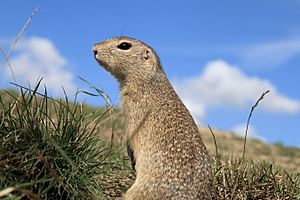
In warmer, southern areas, eagles tend to eat smaller prey. In Georgia, small social voles were the main food. These small rodents weigh only about 35 to 60 g (1.2 to 2.1 oz). Many other small mammals are also eaten. These include different types of hedgehogs, shrews, moles, and many kinds of rodents. Eagles seem to prefer rodents and similar small mammals that live in burrows or open fields near woods.
Many different bird species are also a big part of their diet. More than 120 bird species are known prey. In Europe, common pheasants are very important. In the Hungarian study, pheasants were the third most common prey. In Bulgaria, domestic chickens often replace pheasants in their diet.
In Kazakhstan, a huge study found that birds were the most common prey. This included corvids like rooks and Eurasian magpies. Many types of ducks were also eaten. In Turkey, yellow-legged gulls and white storks are important prey.
In India, wintering imperial eagles often hunt water birds. They especially like young painted storks and cormorants. They also hunt adult water birds like ducks, geese, and large rails. They force diving birds to stay underwater until they are tired. Many pigeons and doves are also eaten. Generally, imperial eagles like to hunt large birds that are easy to spot or have vulnerable young. This includes gamebirds, waterfowl, and corvids.
Eagles also eat reptiles. In Georgia, reptiles made up almost 30% of their diet. This included Caucasian agama lizards. In Turkey, Greek tortoises and Hermann's tortoises were important. Eagles can even catch large snakes, including venomous ones like Russell's viper. Very small numbers of invertebrates (like insects) and fish are sometimes eaten.
Eastern imperial eagles eat carrion (dead animals) all year. But they eat it most in winter. In Jordan, over half of their winter diet was carrion. They will eat almost any dead mammal or bird. This includes at least 10 types of ungulates (hoofed animals).
The size of prey varies. Most live prey weighs less than 2 kg (4.4 lb). On average, prey weighs about 565 g (1.246 lb). In Hungary, prey usually weighs between 250 g (8.8 oz) and 2.5 kg (5.5 lb).
While eagles can take large prey like adult European hares or bobak marmots, they usually catch young ones. They can also hunt large water birds that weigh up to 5 kg (11 lb). This includes geese and common cranes. They might even hunt female great bustards. Eagles also attack young carnivores like foxes and polecats. They sometimes hunt domestic cats. Young ungulates like roe deer and gazelles are also sometimes prey.
Eagle Breeding Habits

Eastern imperial eagles are mostly solitary birds. You rarely see more than a pair together. But small groups might gather at waterholes in winter. When breeding, pairs perform aerial displays. They fly in high circles and call loudly. This shows other eagles that the territory is taken. They might do mock dives or show their talons. If another eagle doesn't leave, they might fight. They can even lock talons and fall towards the ground.
Pairs build very large nests of sticks. Nests can be 1.2 to 1.5 m (3 ft 11 in to 4 ft 11 in) wide and 60 to 70 cm (24 to 28 in) deep. Some nests have been recorded as large as 2.4 m (7 ft 10 in) wide and 2 m (6 ft 7 in) deep. They are often lined with grass, fur, and other materials.
Eagles usually build nests in tall trees. But they have been found in low bushes or even on cliffs. Nest sites can be deep in a forest or in a single tree in open plains. In Turkey and Georgia, nests were usually below 450 m (1,480 ft) elevation. In Russia, they often use conifer trees. In Kazakhstan, they use deciduous trees more. Sometimes, they even nest on electric poles or towers. They have been known to take over nests from steppe eagles on these towers. A pair might have one main nest and one or two backup nests.
The female eagle lays 2 to 3 eggs. This happens every few days. The average clutch size in Georgia is about 2 eggs. In Kazakhstan, up to four eggs have been recorded. The eggs are dull white with grey or purplish spots. They are about 73.3 mm × 56.5 mm (2.89 in × 2.22 in) in size. If eggs are lost early, the female might lay a new clutch. But she will use a different nest.
Incubation starts with the first egg. It lasts for 43 days. The female does most of the incubating. The young eagles hatch a few days apart. One is usually bigger. However, young eagles rarely kill their siblings. So, nests often have two fledglings.
Feathers start growing at 14 days. By 55 days, the young are fully feathered. They try their first flights around 60 days old. The female usually stays with the young. The male hunts and brings prey to a nearby branch for the female to prepare. Once the young are 40 days old, the female also starts hunting again. Young eagles leave the nest between 63 and 77 days old. They stay near the nest for a few days after leaving.
Breeding Success and Survival
The number of young eagles that successfully fledge varies. In the Czech Republic, pairs raised about 1.5 fledglings on average. In Hungary, this increased to 1.15 fledglings per pair. In Bulgaria, it was about 1 fledgling per pair. Older, more experienced eagle pairs tend to be more successful. Nests in lowlands are also more successful than those in mountains.
Young eagles face many dangers after leaving the nest. In Bulgaria, the biggest cause of death was electrocution (59%). This happens when they hit power lines. Poisoning and shooting are also threats. Collisions with cars and wind turbines are also dangerous.
Eagles can also get sick from parasites or viruses. Studies in Kazakhstan and Serbia show that the number of male and female offspring is nearly equal. In Kazakhstan, about 84% of adult eagles survive each year. This is enough to keep the population stable.
However, in some areas, like around Lake Baikal in Russia, the population is declining fast. Fledgling success there has dropped from 71% to 52%. The reasons for this decline are not fully known. But they are likely linked to habitat loss, human land use changes, and pesticides.
Eagle Conservation Status
The eastern imperial eagle's numbers have dropped a lot over time. Long ago, people in eastern Europe and Russia admired this eagle. They called it the "cross-bearing eagle" because of white spots on its wings. Folklore said it could stop hailstorms, saving farmers' crops. The monarchy of Austria-Hungary even used it as their symbol.
But later, people started to view all birds of prey negatively. This led to hunting and persecution. The main reason for the eagle's decline was cutting down old trees where they nested. Less prey and accidental poisoning (from baits meant for wolves) also hurt them. The Industrial revolution made it easier to kill eagles with poisons and guns. In Bulgaria, there were over 1,800 nests in the late 1800s. By 1979, only 5 to 12 pairs remained. In Greece, the eagle disappeared completely as a breeding species.
Today, conservationists are working hard to help the eastern imperial eagle. In 1994, it was listed as Vulnerable. Global protection efforts began. By 2000-2010, the number of breeding pairs in Europe increased significantly. There were an estimated 1,800-2,200 pairs.
The biggest increase was in Hungary. From only 10-15 pairs in the late 1970s, they now have over 100 nesting pairs. Protecting lowlands and educating people about eagles have helped. Poisoning is still a problem, so they work with landowners. Other countries like Slovakia, Czech Republic, Serbia, and Austria have also seen increases.
In parts of Russia and Kazakhstan, the eastern imperial eagle population is stronger. In 2011, there were an estimated 3,000-3,500 pairs in Russia and 3,500-4,000 in Kazakhstan. Cattle grazing in these areas seems to help the eagles. It creates good habitat for their prey, like ground squirrels. The Naurzum Nature Reserve in Kazakhstan is a very important place for wintering eagles. Almost 300 eagles gather there.
However, the population near Lake Baikal in Russia is rapidly declining. In the 1950s, there were 250-300 pairs. By 1999, only 70 pairs remained. The reasons are not fully clear. But they likely include habitat destruction, human land use changes, and pesticides. Although they no longer breed in Pakistan, about 150 eagles still spend winter there.



